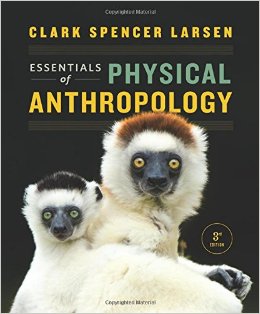Introduction to Physical Anthropology Online Course Information

Wait listed students: Students will be admitted strictly based on wait list position. If you are on the wait list, be sure to check your email regularly the week before the class starts. You'll receive an email from me with information for adding the class, should space become available.
To enrolled students: To ensure that you receive essential information about the course, make sure that your email address in Webadvisor is correct. If not, go to Update Personal Information under User Account settings in Webadvisor and change it. Check your email the week before the start of the semester for any announcements or updates.
If you are currently enrolled and would like to get a jump on things, you can do so by purchasing the textbook (textbook info below) and reading Chapter 1.
What's this course going to be like?
This section of Anthropology 130 is conducted entirely online. There are no in-person class meetings.
Online courses offer you a good deal of flexibility. You can do your work at any computer with Internet access at any time of day. However, you shouldn’t expect an online course to be any easier than a traditional face-to-face course. On the contrary, online courses are often more demanding, as they require active learning, participation and self-motivation on the part of the student. You will do more reading and writing than a student taking the "in-person" version of this course.
This course is NOT self-paced. Although you may read and work ahead to some degree, you will need to participate in online discussions, meet deadlines for assignments and take exams within specified dates. However, there are no specified times in which you need to be online--you may access the course material and post on message boards at any hour of the day.
Required reading
1. The textbook: Essentials of Physical Anthropology by Clark Spencer Larsen, 3rd ed. (2016). W.W. Norton & Company. ISBN-13: 978-0393938661 . Available in the Grossmont College Bookstore, as well as numerous online booksellers. A copy of the text will also be on reserve in the GC library.
**Note--There are several changes in the new 3rd edition of the book, including the use of an updated classification system for the primates and hominids (human ancestors). While it is possible to use the previous edition, anyone who chooses to do so is responsible for any differences between the editions.
You can also purchase the text as an "E-book" directly from WW Norton or CourseSmart. The text may also be available through textbook rental services such as Chegg. When purchasing or renting a text online, make sure to carefully read the agreement, so that you understand the terms and conditions of your purchase.
2. Online lectures. These will be available through the Course website on Blackboard.
3. Selected websites and articles. Links to these readings can be found within the online lectures.
Access to the course
Students will access the course through Canvas. Log into Canvas on the first day of the semester and the course should be visible.
Work requirements
There are no required pre-requisites for Anthropology 130, and no prior knowledge of anthropology is necessary. However, it is strongly recommended that students be competent in reading and writing at the level of English 110 or higher. Students who lack such competencies will find it very difficult to succeed in this course.
Detailed information about specific assignments, grading procedures, and the semester schedule will be available on Blackboard. Here is a summary of what work to expect.
Assigned reading including the text chapters, the online lectures, and any online articles or websites.
"Virtual Labs" created by your textbook author which require you to access outside web resources and multimedia on anthropology. You will go through the Virtual Lab activity, respond to questions and/or write short essays.
Participation in Discussion Boards organized around a specific topic. This includes posting new threads, as well as responding to the posts of other students.
Exams consisting of multiple choice questions.
What is Physical Anthropology? What topics will this course cover?
Anthropology, in the broadest sense, is the study of people. Physical anthropology explores the nature of humans from an evolutionary perspective and provides a means of observing and understanding ourselves and our history as a species.
This course is divided into four sections.
1. An introduction to anthropology, science and modern evolutionary theory, as well as basic principles of genetics.
2. The biological diversity of human populations.
3. The ecology and behavior of our closest living relatives, the primates.
4. The fossil evidence for human origins and the evolution of human culture, social organization and cognition.
Throughout the course we will examine the dynamic interaction between biology and culture that is a hallmark of our species.


8800 Grossmont College Drive
El Cajon, California 92020
619-644-7000
Accessibility
Social Media Accounts